By Typie
WhatsApp marketing assistant
WhatsApp Marketing
,GDPR
Ready to chat with your customers on WhatsApp without stepping on any GDPR toes? Take a look at our a no-jargon guide to getting the right permissions in WhatsApp in a GDPR-compliant way.
A WhatsApp opt-in is the first step to building your customer relationships in WhatsApp.
Rather than seeing it as inconvenient work, see it as a chance to be respectful to customers and set the right foundations for a happy, long-term relationship.
A bit like a first date 👨❤️💋👨
A WhatsApp opt-in is the perfect time to reassure your customers that you'll treat them right in WhatsApp. It's the place to establish your brand in WhatsApp too: let customers know what they can expect for you in this channel.
And it's an important time to find out about customers, ask them what they want to hear from you, and even make your first sale.
 Here's a sample WhatsApp opt-in showing the double opt-in process and a brand using the chance to find out about customers, shown in charles automation feature, Journeys
Here's a sample WhatsApp opt-in showing the double opt-in process and a brand using the chance to find out about customers, shown in charles automation feature, Journeys
What's a WhatsApp opt-in?
A WhatsApp opt-in is your customer's agreement to receive messages from your business over WhatsApp. Typically these are marketing messages, but they could also be tracking updates or order confirmations.
This isn't just a formality. A WhatsApp opt-in is a necessary step to ensure your communications are welcome, expected, and beneficial to both parties.
And for EU companies: it's the law.
To comply with GDPR, a business needs to obtain proper and demonstrable express consent from its customers. The best practice to do so is the double opt-in procedure [but it's not strictly speaking required under GDPR].
Make WhatsApp opt-ins 100% transparent
Transparency is key.
Never hide things or confuse customers with complex wording.
Not only is this unethical, it will backfire later on down the line when customers get irritated because your messages don't meet their expectations.
When you ask for consent, clearly state that the customer is opting in to receive messages from your business on WhatsApp.
Ask your customers what they want to hear from you in WhatsApp. This will set expectations for the future and avoid surprises (or even being blocked) later on.
Specify the type of content they should expect, whether it's promotional offers, updates, or customer service communications.
Even better: ask them what they want to hear from you. You will lose fewer people than you think at this point because customers appreciate having a say in the notifications they receive, and the more personalised the better.
You'll also find that the subscribers you have, who have stated what they want to hear, will be more loyal and will not be upset by receiving the wrong kind of notification.
![]() You can see more about how to do WhatsApp messaging the right way in the WhatsApp Business Messaging Policy.
You can see more about how to do WhatsApp messaging the right way in the WhatsApp Business Messaging Policy.
Keep WhatsApp opt-ins GDPR compliant
A double opt-in mechanism is a best practice to ensure consent is obtained demonstrable and proper in line with GDPR.
If businesses didn't do this, anyone could put your number into a website popup and sign you up to newsletters. Or any company could get your number and start sending you WhatsApp messages.
After the initial WhatsApp opt-in, you send a confirmation message over WhatsApp asking the customer to confirm their subscription by replying with a keyword like "YES."
A professional WhatsApp opt-in example from WhatsApp, shown in Journeys, charles' WhatsApp automation feature. It asks customers to confirm "YES" that they want marketing communications in WhatsApp and is the second part of a double opt-in. When customers click "YES," they automatically get a tag to say they've given the right permissions – which brands can use to segment audiences later on.
How to create a double WhatsApp opt-in and high-performing welcome flow
Creating a WhatsApp opt-in is straightforward and entirely automated. You can do this in the charles platform with Journeys.
Here are the steps to create a winning WhatsApp opt-in and welcome flow:
1. Set a single opt-in trigger message
Write a message to trigger the WhatsApp opt-in flow.
When a customer taps your wa.me link on their phone, or scans a QR code, a WhatsApp chat will open. A message will be prefilled with this text. The customer then needs to send this to you to start the automated WhatsApp double opt-in flow.
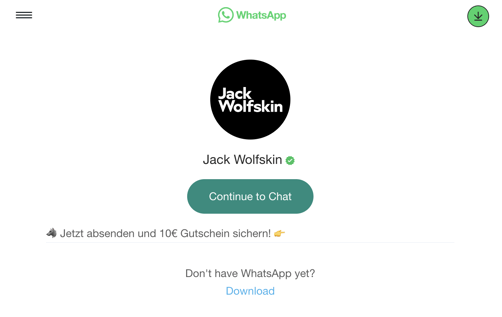
Tap on a wa.me link and you get a screen like this. Tap on the button and the WhatsApp chat with Jack Wolfskin with open. Send the prefilled message in the WhatsApp chat and that will start the opt-in flow.
Want your own "wa.me" link?
It only takes a minute with our WhatsApp link generator.
In the charles platform, you can choose to trigger this message with those exact words, or just some of these words.
Be careful to keep trigger messages different for each flow so you don't trigger more than 1 flow with the same words (in charles you get an error message if you do this).
![]() Typie's tip: Keep the trigger message short but explanatory. WhatsApp is still quite new as a marketing channel for customers, so some companies even state "send this message to us" in the trigger message.
Typie's tip: Keep the trigger message short but explanatory. WhatsApp is still quite new as a marketing channel for customers, so some companies even state "send this message to us" in the trigger message.

"Hey leevje, I'd love to sign up for your WhatsApp news" triggers leevje's WhatsApp opt-in flow
and second opt-in (see leevje success story here)
2. Add automated double opt-in message
The message above will trigger your GDPR-compliant WhatsApp "double opt-in" message.
Keep it short and clear and honest, like: "Please confirm you want to hear from us in WhatsApp." Then add "YES" and "NO" buttons, ideally in capital letters for easy reading.
![]() Typie's tip: make sure the YES button is on the right and NO on the left. YES tends to be nearer people's thumbs and easier to press :)
Typie's tip: make sure the YES button is on the right and NO on the left. YES tends to be nearer people's thumbs and easier to press :)

leevje says: "Hey {name}, welcome to our WhatsApp news! Want to be the first to hear our about exclusive offers and a 10% welcome discount. Tap "Yes, I'm in"
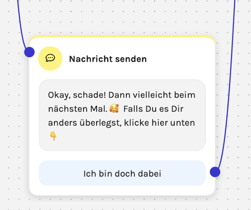
What if someone taps "NO"? Send them a friendly message saying "No worries. If you want to join us again, tap this button." This will stay in the WhatsApp feed if they want to rejoin in future.
3. Add "double opt-in" tag to help you create lists in future
Once someone has tapped "YES" to receiving your message, congratulations, they're double opted in and you are legally allowed to send marketing messages.
This doesn't mean you should overdo it of course! But the customer now expects to hear from you, so now it's time to think about the value you can offer them in WhatsApp and start strategising.
So you can segment lists of only doubly opted-in customers, add a "Double opt-in" tag to everyone who has tapped YES.
It's a good idea to also add a tag saying where the customer came from. In this image you can see it's from the 10% off website popup. This will help you personalize future campaigns.
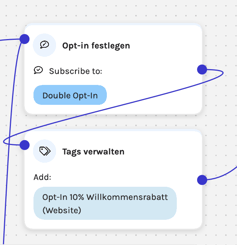
This is how leevje adds tags in its welcome flow
Bonus steps to optimize your WhatsApp opt-in flows
Your customers is now opted in and ready. You don't need to do anything else.
BUT
We recommend adding a good welcome flow to get the most out of WhatsApp and your customer relationships. Remember, this is where you start your relationship. It's a good idea to use this flow to add more tags so you can personalize campaigns better in future.
This is not only good for business, it's good for customers. No one wants generalized, spammy WhatsApp messages.
It's surprising how many customers finish these flows. They appreciate having control over the types of message you send and give this information willingly.
![]() Typie's tip: choose a platform like charles that offers excellent support and WhatsApp advice. Our first focus is on maximizing ROI and retention, which is why many brands choose us to partner with them for the long-term.
Typie's tip: choose a platform like charles that offers excellent support and WhatsApp advice. Our first focus is on maximizing ROI and retention, which is why many brands choose us to partner with them for the long-term.
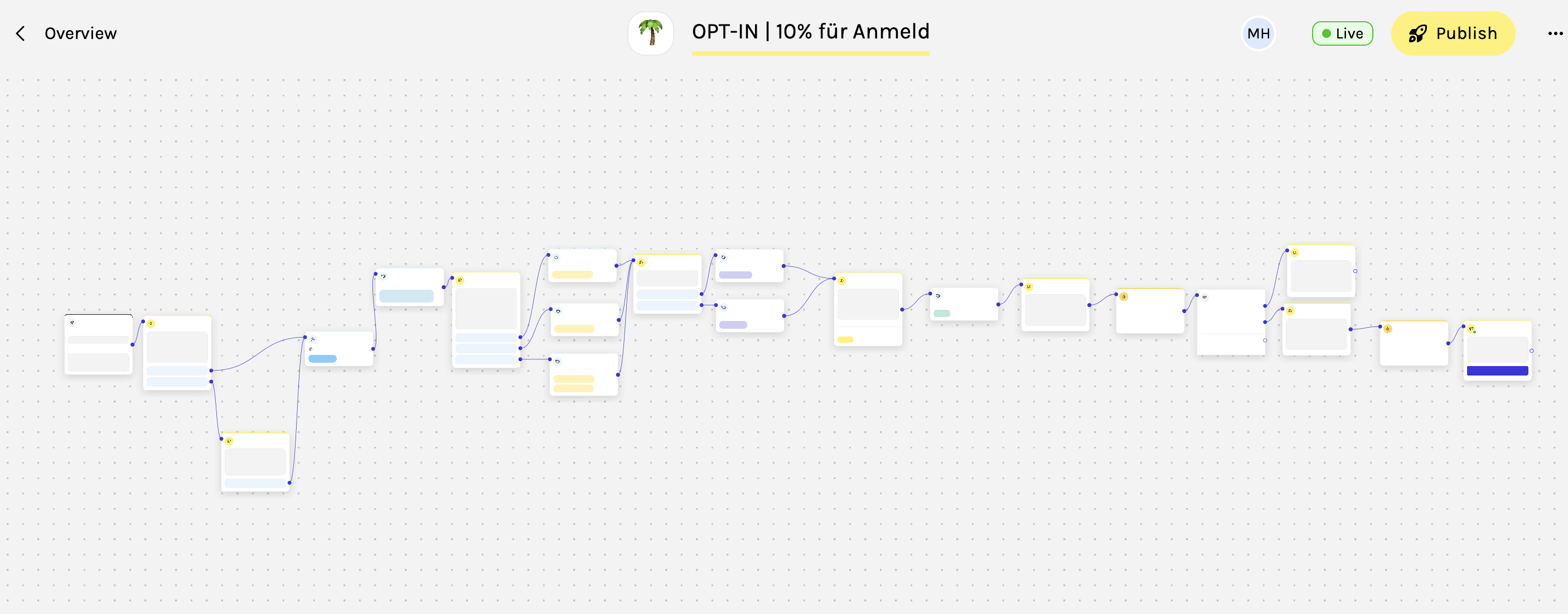 This is leevje's full WhatsApp opt-in and welcome flow. The opt-in part is 1/3rd of it. The rest is 2/3rds. It's optimized to set leevje up for maximum ROI in future and is worth spending time on testing and getting it right.
This is leevje's full WhatsApp opt-in and welcome flow. The opt-in part is 1/3rd of it. The rest is 2/3rds. It's optimized to set leevje up for maximum ROI in future and is worth spending time on testing and getting it right.
4. Learn about your customer and add tags
Ask your customers 1-3 questions (no more) about their preferences and add tags to their profile. With the right integrations (for example Klaviyo and Shopify) you can bring this data to other CRM and shop systems for a broader picture of your customers (worth a great deal in this now cookieless world).
Typically at this point brands ask quick, easy questions like:
- What do you want to hear from us in WhatsApp?
- What kind of products/styles are you interested?
- What's your skin type?
- What's your email address?
- What's your favorite color/animal/season?
These questions will depend on your brand and your business goals. Choose those that will give you the highest value later on.
Use buttons rather than lists for ease – which means you should have maximum 3 answer choices.
 Typie's tip: tell people up front how many questions you're going to ask to set expectations and reduce drop offs. (Bonus: it's good practice for readability and clarity to use actual digits (1, 2, 3...) rather than spelling out the numbers in WhatsApp messages.)
Typie's tip: tell people up front how many questions you're going to ask to set expectations and reduce drop offs. (Bonus: it's good practice for readability and clarity to use actual digits (1, 2, 3...) rather than spelling out the numbers in WhatsApp messages.)

leevje asks 3 questions: what type of styles you're interested in, what kind of messages you want to get in WhatsApp (just important info or deals, news and info) and your email address
This information is golden because you can now send highly personalized and targeted messages to customers – reducing the number of messages they receive, and ensuring a great experience for them.
Learning a customer's email address at this point is a great idea – for a smooth CRM journey and to make sure they receive the right message in the right place at the right time.
5. Send the discount code
Once customers have opted in and answered some questions, send them what they want: the discount code.
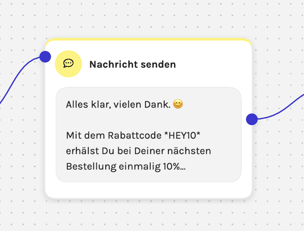 Now it's time: show them the discount code
Now it's time: show them the discount code
![]() Typie's tip: customers don't mind (and usually expect to) giving you something before they get the discount code, so keep it until this point. If you give it too early, they have no incentive to answer your questions and are likely to drop off.
Typie's tip: customers don't mind (and usually expect to) giving you something before they get the discount code, so keep it until this point. If you give it too early, they have no incentive to answer your questions and are likely to drop off.
6. Send a reminder to use the discount
This isn't a must, but you could consider sending them a discount reminder. Give a discount code that expires within 1 day or 1 week, so you have a reason to send another message.
In the charles platform, when they use the discount code, they get a tag saying they've used it, so you can send different messages to those that have sent the code, and those that haven't.
In leevje's example below, they send a nice brand message before sending a reminder – after an automated 10-hour time delay. If a customer has used the code, that's the end of the welcome flow.
If the customer hasn't used the discount, they get a short, sweet reminder to use the discount code after another 10 hours.
Don't send more than this or customers will start to feel it's too much. It's not worth losing a customer at this point just to get a quick sale. The sales will come :)

leevje sends a gentle discount reminder after sending a nice brand message from the founders to strengthen relationships
Keep records of WhatsApp opt-in consent
Maintain detailed records of when and how consent was given.
This is crucial for GDPR compliance. Ensure that the customer's agreement is stored securely and can be easily accessed or deleted if they ask.
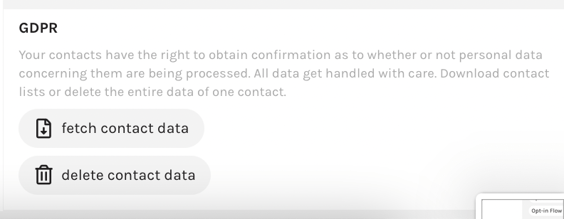
In the charles platform, we educate customers about their GDPR requirements and it's full of features to make it easy to comply
Easy ways to get WhatsApp opt-ins
You need to build subscribers to have a profitable, thriving WhatsApp channel.
There are many ways to encourage customers to opt in and you should use all of them 🐙:
- Website checkbox: A simple checkbox (not pre-checked) on your sign-up form or during the checkout process (remember to ask for their phone number).
- Website popups: This is how our customers get most of their subscribers. They put a popup (powered by charles) permanently on their website. This can be tailored to your brand and adapted for seasonal or sales events. Consider adding a 10% discount for subscribers. Many of our customers add WhatsApp opt-in popups on mobile and email opt-in popups on desktop – for a smoother customer journey.
- Thank you page on your website: After an order has been placed is the perfect time to ask for a WhatsApp opt-in. The customer is happy and excited to get their order. Offer them WhatsApp order updates. Most customers appreciate the ease and reassurance of getting updates in such an immediate channel.
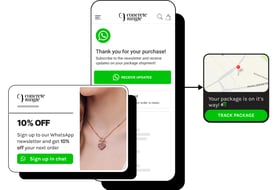 Offering WhatsApp order updates on the thank you page works very well, like Concrete Jungle does
Offering WhatsApp order updates on the thank you page works very well, like Concrete Jungle does
- In-store codes: put up QR codes that customers can scan to initiate a WhatsApp conversation, serving as an opt-in. Offer to send their receipt in WhatsApp.
- Email links and QR codes: Encourage opt-ins via email or SMS by providing a direct link to start a WhatsApp chat with your business.
- Ask for WhatsApp permission when getting email address: and vice versa, get email addresses when getting a WhatsApp opt-in. When you have both email and WhatsApp contact details, our customers see a customer lifetime value (CLV uplift of 25%).
- QR codes on your packaging: An order's just arrived? The perfect time to offer a leaflet for a discount off the customer's next purchase, or make the whole box into a QR code 😉

Our customer Jack Wolfskin has this WhatsApp banner permanently on its website
![]()
See more in our article: Grow your WhatsApp audience.
Make WhatsApp opt-outs easy
Customers must be able to withdraw their consent at any time easily. Include instructions on how to opt-out in every message, typically by replying with a word like "STOP."
 You can see the GDPR unsubscribe on all of Dermalogica's WhatsApp messages – using charles "global opt-out footer" feature. It's clearly visible while being greyed out so it doesn't distract from the marketing message
You can see the GDPR unsubscribe on all of Dermalogica's WhatsApp messages – using charles "global opt-out footer" feature. It's clearly visible while being greyed out so it doesn't distract from the marketing message
Add WhatsApp opt-in section to privacy policy
Update your privacy policy to include information on how you use WhatsApp as a communication channel, how users can opt-in or opt-out, and how their data is protected. See WhatsApp opt-in wording on our customers' pages, like Jack Wolfskin (see 10.1) and L'Occitane.
To sum up: good WhatsApp opt-ins start strong relationships
A good, double WhatsApp opt-in is a must to set the foundation for profitable and enjoyable future relationships with your customers. And in the EU, a double opt-in is the law – you can be fined for doing it wrong.
A WhatsApp opt-in is the time to add a welcome flow too.
Your welcome flow is key to sending relevant and timely materials in the future, so spend some time (with your WhatsApp Business Solution Provider or WhatsApp marketing agency) getting this right. After all, when you're automating at scale, you still want to offer some degree of personalization.
Get the opt-in part right and you're set up for life to earn stable retention revenue and keep building loyal WhatsApp fanbase.
Legal notice: the points raised in this article are not exhaustive – this is not a complete list of opt-in requirements to stay compliant with GDPR. We've shared only on the most important issues and questions that arise in regard to WhatsApp opt-ins and GDPR. In each individual case, additional requirements in terms or wording of opt-in messages may be required.
Questions about WhatsApp opt-ins?
Just ask. We've been doing this for 4 years and know how to stay GDPR compliant – as well as maximize revenue during WhatsApp opt-ins and welcome flows. Get a free 30-minute demo.
Disclaimer: the information in this article is based on our experience and expertise and is not offered as legal or data privacy advice. For full information on your legal obligations under GDPR, please go to the European Commission's official GDPR site.
FAQs about WhatsApp opt-ins
What is a WhatsApp opt-in?
A WhatsApp opt-in is a customer's explicit consent to receive messages from a business via WhatsApp. Just as with emails or in-app notifications, companies need to ask customers permission before sending them marketing communications. This is done to respect customers and keep them in control over what notifications they get, and in some countries, it's the law (e.g. GDPR in the EU).
Why is GDPR compliance important for WhatsApp opt-ins?
Compliance with the General Data Protection Regulation ensures that personal data is processed lawfully, transparently, and securely, enhancing customer trust and protecting the business from potential penalties. EU companies must adhere to these regulations by law. Outside the EU, GDPR is becoming the global golden standard for businesses. The lack of GDPR governance in India for example is part of the reason there's a rise in WhatsApp spam, which cannot happen in Europe.
Can I automatically add my existing customers to my WhatsApp messaging list?
No, you must obtain explicit consent through a WhatsApp opt-in, even if they're existing customers. An email opt-in doesn't count as permission to send messages in WhatsApp.
How can customers opt-in to receive WhatsApp messages?
Customers can opt-in through your website, in-store via QR codes, or any communication channel by expressing their consent clearly. They scan a QR code or tap on a link and this automatically opens a WhatsApp chat with your brand. A "double opt-in" is a good idea for GDPR and looks like this: the customer sends your brand a prefilled message that you write (opt-in 1). This triggers an automated message asking them if they're sure they want to hear from you in WhatsApp, with YES and NO buttons (opt-in 2). You should always add an option to unsubscribe at any time (most companies say you can send them "STOP" on WhatsApp to opt out). In the charles platform, you can add a "global opt-out footer" so this message is at the bottom, in grey, of every message you send.
What should I do if a customer wants to opt-out?
Let them! And make it easy. Remember, people opt out for many reasons that don't always mean they're annoyed with your brand or messages. Instructions for opting out should be clear and included in your very first message and then ideally in every message. In charles this is with a global "opt-out footer" with greyed out text at the bottom of the message, like an unsubscribe footer in an email.
What's a double opt-in in WhatsApp?
A "double opt-in" in WhatsApp means asking customers twice if they want to hear your marketing communications in WhatsApp. The flow is automated (in charles with Journeys) and goes like this: the customer sends your brand a prefilled message that you write (opt-in 1). This triggers an automated message asking them if they're sure they want to hear from you in WhatsApp, with YES and NO buttons (opt-in 2).
![How to make the perfect WhatsApp opt-in for businesses [GDPR compliant] blog](jpg/gdpr%2bwa-main%20(1)cca4.jpg)
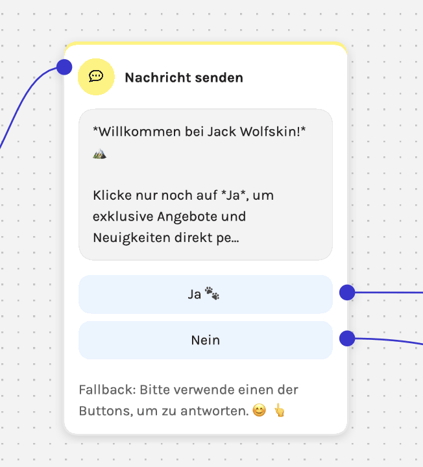
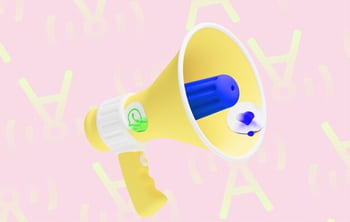
![How to add WhatsApp to an omnichannel strategy [+5 benefits] | charles](jpg/octopus%20whatsapp%20omnnichannel%20strategy%20article%20charles%20preview71ee.jpg)

![How to choose WhatsApp marketing software [12 must-haves] | charles](jpg/01%20preview4411.jpg)